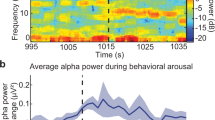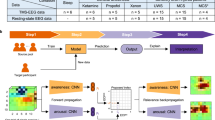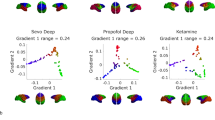Abstract
Arising from: N. D. Schiff et al. Nature 448, 600–603 (2007)10.1038/nature06041; Schiff et al. reply
Schiff et al.1 show that deep-brain stimulation of the unspecific thalamocortical system through certain midline thalamic nuclei produces an alerting effect in a patient in a minimally conscious state. Such nuclei include the central lateral nucleus, paralaminar regions of the median dorsalis, and the posterior–medial aspect of the centromedian/parafascicularis nucleus complex.
Similar content being viewed by others
Main
Hassler and colleagues published a similar study, with certain methodological differences, in 19692,3. Their aim was similar, namely the alerting of consciousness by activation of anatomically undamaged neurons in the unspecific thalamocortical system. McLardy et al.4 were also motivated by the same concept, but gave little detail of methodology and failed to produce a result. Several reports followed, but that by Schiff et al., though it concerns only a single case, is the most detailed and is strengthened by its internal statistical control.
Hassler’s subject2 is described as having a post-traumatic apallic state. This term derives from the original description by Kretschmer5 of a state of waking either without awareness (as seen in the vegetative state), or with minimal awareness (as in the minimally conscious state). Hassler stimulated pallidum on the basis that it feeds into the unspecific system as well as the specific system. This view was supported at the time by the elicitation of recruiting responses (incremental high-voltage synchronizing waves, usually, though not always, of long latency, carried over the unspecific thalamocortical system6) by stimulation of pallidum7. The dipole for such laminar field potentials is in the superficial layers of the cortex8. This is perhaps concordant with the later demonstration of the ubiquitously distributed matrix of calbindin-immunoreactive neurons, which project to the superficial layers of wide areas of cortex9,10. Hassler also chose the basal portion of, using his terminology, the latero–polar nucleus of the thalamus on the opposite side.
As a neurologist, a neuroanatomist who wrote the anatomy of the thalamus for the Schaltenbrand stereotactic atlas, and someone with a wide experience of stereotaxy, Hassler was well placed to make the foregoing contribution.
References
Schiff, N. D. et al. Behavioural improvements with thalamic stimulation after severe traumatic brain injury. Nature 448, 600–603 (2007)
Hassler, R., Dalle Ore, G., Dieckmann, G., Bricolo, A. & Dolce, G. Behavioural and EEG arousal induced by stimulation of unspecific projection systems in a patient with post-traumatic apallic syndrome. Electroencephalogr. Clin. Neurophysiol. 27, 306–310 (1969)
Hassler, R., Dalle Ore, G., Bricolo, A., Dieckmann, G. & Dolce, G. EEG and clinical arousal induced by bilateral long-term stimulation of pallidal systems in traumatic vigil coma. Electroencephalogr. Clin. Neurophysiol. 27, 689–690 (1969)
McLardy, T., Ervin, F., Mark, V., Scoville, W. & Sweet, W. Attempted inset-electrodes-arousal from traumatic coma: Neuropathological findings. Trans. Am. Neurol. Assoc. 93, 25–30 (1968)
Kretschmer, E. Das apallische Syndrom. Gesamte Neurol. Psychiatr. 169, 576–579 (1940)
Morison, R. S. & Dempsey, E. W. A study of thalamocortical relations. Am. J. Physiol. 135, 281–292 (1942)
Dieckmann, G. Cortical synchronized and desynchronized responses evoked by stimulation of the putamen and pallidum in cats. J. Neurol. Sci. 7, 385–391 (1968)
Sasaki, K., Staunton, H. P. & Dieckmann, G. Characteristic features of augmenting and recruiting responses in the cerebral cortex. Exp. Neurol. 26, 369–392 (1970)
Jones, E. G. & Hendry, S. H. C. Differential calcium binding protein immunoreactivity distinguishes classes of relay neurons in monkey thalamic nuclei. Eur. J. Neurosci. 1, 222–246 (1989)
Jones, E. G. The thalamic matrix and thalamocortical synchrony. Trends Neurosci. 24, 595–601 (2001)
Author information
Authors and Affiliations
Rights and permissions
About this article
Cite this article
Staunton, H. Arousal by stimulation of deep-brain nuclei. Nature 452, E1 (2008). https://doi.org/10.1038/nature06574
Received:
Accepted:
Issue Date:
DOI: https://doi.org/10.1038/nature06574
This article is cited by
-
The vegetative and minimally conscious states: a review of the literature and preliminary survey of prevalence in Ireland
Irish Journal of Medical Science (2013)
-
Schiff et al. reply
Nature (2008)
Comments
By submitting a comment you agree to abide by our Terms and Community Guidelines. If you find something abusive or that does not comply with our terms or guidelines please flag it as inappropriate.



